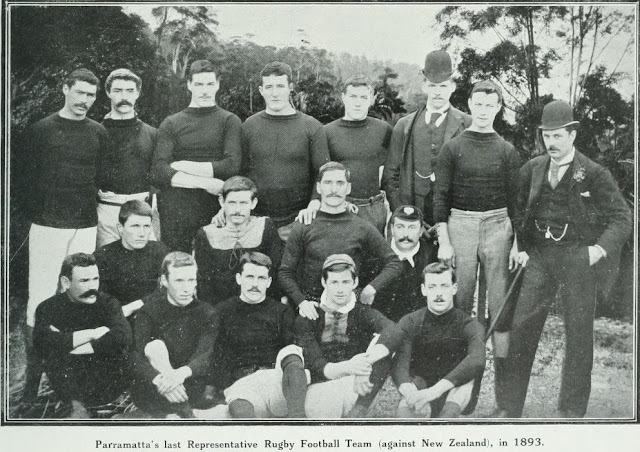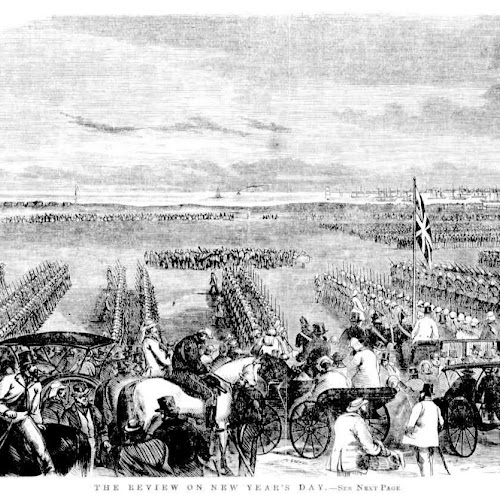Pictured: Parramatta's Last Representative Rugby Football Team (against New Zealand), in 1893
Back: James Sorlie, Lester Wickham, Guy Tibbetts, J. A. Fraser, A. G. Fraser (W. Fairclough), Mal Tunks, (H. Schwartzkoff).
Second Row: F. W. Todhunter, W. Pye, T. Walters, McClutchie.
Front Row: Oxby, R. Bauchop, A. Eady, Stan. Wickham (in his first big match), Wilson.
FOOTBALL.
By Mr. George. B. Davey
(The Jubilee of Parramatta, 1911)
By Mr. George. B. Davey
(The Jubilee of Parramatta, 1911)
In the 1870's football began to make its influence felt among the games and pastimes of this part of the world. Men from the playing grounds of the Great Public Schools of England, where the Rugby game was followed as a matter of course, and most enthusiastically believed in, first began to wonder why it should not teach its strenuous lessons of pluck, forbearance, endurance and general manliness in these Southern climes, among schoolboys and others; then commenced to talk among themselves, and to organise. Clubs were formed in connection with the University. The King's School (T.K.S.), and the Sydney Grammar School; the old Wallaroos and the Waratahs and a few other fifteens visited Parramatta district occasionally and in matches with T.K.S. gave exhibitions of the character of the new-game.
The magnet soon drew Mr. Fred. Lassen, a resident who had carried off in marriage one of the fair belles of the town, and who held a position just then in the local post and telegraph office, started out to see if some of the local lads could not learn to form scrums and side-step and tackle.
A Parramatta club was formed; and the members, in their green and white jerseys, rolled individually in, as it were, the heavy sea-way of unaccustomed and violent exercise, and limited finesse in respect of the strategy and tactics of the new game. The Ashbys, the brothers Byrnes, the brothers Griffin, C. Morley, Peacock, W. Webb, the late F. Lovell (one of the founders of "The Argus"), G. Tunks, C. and G. Howell, G. Coates, Thompson (from Pennant Hills, and others - some of them heavyweights - gave up their Saturday afternoons to the ordeal of practising in Rugby games, and matches were arranged.
Thus began in Parramatta the acclimatization of the grand winter game of England.
Matches were won and lost, in which Parramatta's weight told, if skill was not always a predominating factor in the ruck. W. Coates came from Newington College - just down the river then (and where already the game had got a good hold) - and with him came along some strides of science. He was the Prince Charming of the dodgy run. Of course, the rustics looked askance upon science, expecting men like McFarline, of Liverpool, and some of the heavy-weights of Parramatta to smash down all opposition in the contests in which they took part. But, though C. Morley and the brothers Hicks, G. Stettler, Tom Moxham (now Mr. T. R. Moxham, M.L.A.), and others ran strongly and bumped, it began to dawn upon those who went over to the "back of the Park" weekly, to see the matches - and noticed the present ex-Premier C. G. Wade, the Manchees, the Whites, Bode, Ted. Brown, "Monty" Arnold and others being trained by Raper and Burkitt - and saw Mr. W. S. Brown, then a stripling, sending left foot drop-kicks from cunning angles over the bar - that strength without science was not everything.
A younger generation afterwards arose. We saw the late Jas. Houison's great kicking from full back, and the Frasers ("Jumbo" and A. G.). strong doughty players, taking their part in games between the new-born Unions and Nomads and Carltons; and the appearance was hailed of rising stars in the brothers Wickham (Edwin and Ern., and Leslie and Alf.), in Fred. Weston, the Garlicks, the late Tom Auchterlonie, W. Taylor. Wally Suttor (now an enthusiastic worker in the Salvation Army), MacWhirter, Harry Davies (now head official of the N.S.W. Government Savings Bank), Les. Bowden, Bennett (of T.K.S.), F. Firth, A. Dunlop. Watt. Mingaye, the brothers Crook, H. Schwartzkoff, Neich, E. Miller, Hilder, E. Mason, J. R. Thwaite, Harry Davey (a forward, at present revelling in unofficial civic stress - if the phrase may be pardoned as being used to describe work like that of the local Progress Association for the benefit of "The Road." Carlingford), T. Hellyer, "Jacky" Martin, Albert Davey, W. Davies, and hosts of others. Regular matches were instituted with Sydney and suburban and school clubs, and the fame of Parramatta players spread, and that not undeservedly.
A Parramatta pen called the attention of the powers that be to the promise, in Rugby, of Parramatta lads; and Suttor was chosen to play for New South Wales. He obtained his "blue"; and in a well-remembered, historic match tried (when perhaps it was not exactly "the game'") to drop a goal, a thing he had never been known before to attempt, since he generally was at the heel of the scrum. Later on Les. Wickham, M. Tunks, the Frasers (Jack and "Soong"), and others got into the big teams; but all the story of that belongs to a later time, as too does the tale of how came along in his might Stan. Wickham, now only just retired from the game (an ex-international skipper of many years), and perhaps the greatest player the town of Parramatta has produced (if we make a complimentary reservation with reference to his brother Leslie - in deference to the enthusiastic appreciation by his compeers of the latter player's phenomenal skill).
This is not intended to be an article giving particular analysis of men's play; but the sport was clean and good in those golden days of 20 or 30 years ago, when Weston was full back of the famous "Reds," and Leslie Wickham (he of the wriggling run), was centre half, and his brother was on one wing (with Eedy on the other), or played quarter - as the present halves were then styled - with Suttor; and the town rejoiced exceedingly in the quality of the work, as F. Bellbridge, formerly a mighty University player, led on "Jess" Griffin and Cairns, Fred. Todhunter, R. C. Bartlett (Alderman, now, of Parramatta), W. Pye, W. Fairclough, and others. So long as good, clean sport lives in the memory of the men (and of a good many of the fairer sex ) of those days the games on the Back Domain will be remembered. And the names of men will come crowding up - Shortus, Tibbets, Tom Carpenter, S. Fairclough, W. Fairclough, Mal. Tunks, Jack Tunks, Tom Williams, and lots more sturdy and strong.
Visiting teams from Queensland and from New Zealand were met; and if the local players did not always win they covered themselves with credit. Well indeed does the mind go back to that game against the Bananalanders on Elizabeth Farm, when Lamrock, Corderoy (skipper), Little, H. Hicks, Godfrey Stettler, Peacock, Jas. Byrnes. Crook, Gill, Auchterlonie and others (drawn from the local clubs) did great things, scoring a win, thanks to a run-through by Stettler (one of the local peds. of the day) from right back to the Queenslanders' line; and also to that Homeric struggle on the Parramatta cricket ground, when Bauchop, as a dancing dervish of a "Red" wing-forward, puzzled both opponents and referee, and stabbed with infinite tricky darts the "Maoris'" work about their scrum, whilst Jim Sorlie, then recently imported from "Soccer," brought his marvellous foot play into execution, and Heffernan (the policeman) did great things in bare socks. On that day Parramatta rejoiced with an exceeding great exultation.
In those days Parramatta football reached its height. The "Reds" furnished skippers for the inter-State and international teams in J. Fraser and Bellbridge, and sent to New Zealand and Queensland representatives quite regularly. Then, too, the Parramatta representatives carried off the Premiership honors in the same year that the King's School won their championship.
The games in Sydney, or at Parramatta, were followed regularly by great crowds of supporters - a mighty army of men and boys from the historic borough. Enthusiasts like E. Gould (now of Goulburn) were full of facts and data, and figures of record; and the late H. Tunks and other rising young players were the heroes of the hour.
Then, gradually, came a sort of re-action; and the game of Rugby, in "town" circles, though not in the T.K.S. sphere, passed behind a slight mist, as the moon pales behind a scudding cloud. The old favorites took to other, perhaps even grander themes, in business, or otherwise; some took to bowls, to "gowf," to tennis, or went abroad; and Rugby was left to younger clubs.
Now the fifteens of Parramatta district are legion,and the noise of their struggles makes the welkin ring o' Saturdays.
But the internecine struggle between League and Union, or some other cause, has cast the mantle of comparative quiet over the glory of Rugby in Parramatta.
For a liitle time the "Soccer" game was played P. Adams, the late David Rea, J. Adam, R. J. Brown, Constable G. Rawe (who gave his life for Empire in a war in South Africa), Hopkinson, and a few other devotees of the game with the round ball, giving exhibitions with the rest of their team, and playing matches, on the far side of the Serpentine creek, Parramatta Park, near the western lodge. But to-day there is no "Soccer" played, save by schoolboy's, in Parramatta.
Provenance: "The Jubilee History of Parramatta". In Commemoration of the First Half-Century of Municipal Government, 1861-1911. Edited by J. Cheyne Wharton.
Arthor: Edited by J. Cheyn Wharton
Date of Publication: 1911
Publisher: Thomas D. Little and Richard Stewart Richardson, The Cumberland Argus Printing Works
Place of Publishing: Parramatta, New South Wales
Copyright status: This work is out of copyright
Courtesy: University of California Libraries via the Archive Org.











No comments